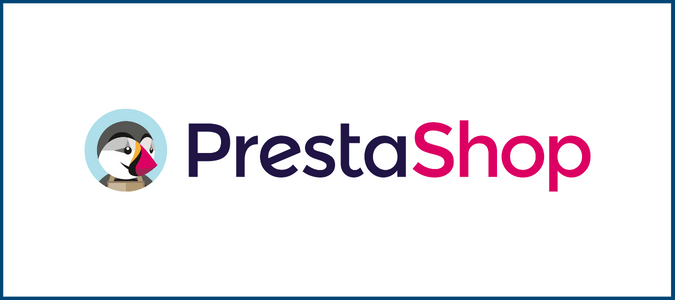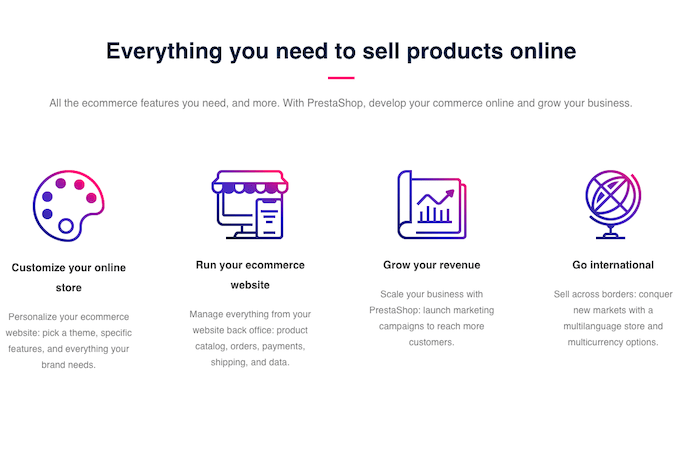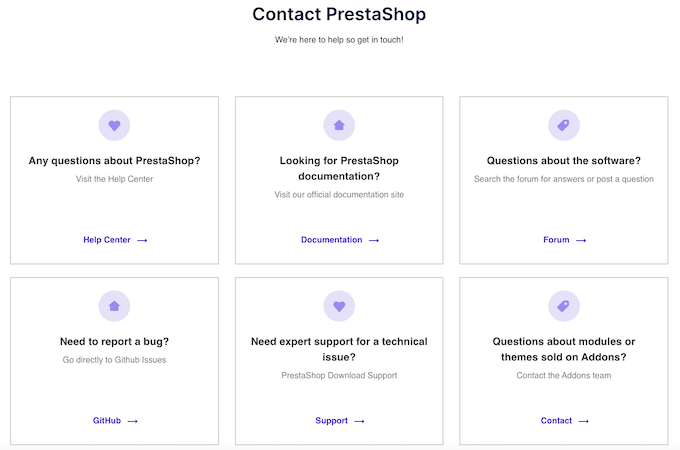PrestaShop is the leading open-source ecommerce solution allowing you to create and manage multiple online stores. It has a highly responsive interface with hundreds of advanced built-in functionalities and tools, from payment processors and inventory management to support for multiple currencies and languages.
PrestaShop helps you create a customized ecommerce site for your business, owned and designed by you, in minutes. Below, you’ll learn all about what this platform does well and where it falls short.

PrestaShop Compared
PrestaShop didn’t make our top list of the best ecommerce platforms, a category crowded with quality options. Instead, our top recommendation is Shopify, which offers merchants the perfect mix of beginner-friendliness and advanced features. Sign up for a three-day free trial of Shopify.
- Shopify – Best all-around ecommerce platform
- Wix – Best for stores with fewer than 100 products
- BigCommerce – Best for large inventories
- Squarespace – Best for cornering a niche market
- Hostinger – Best price for a full online store
If you’d like to learn more about these alternatives to PrestaShop, read our full post reviewing the best ecommerce platforms.
About PrestaShop
PrestaShop is a free, user-friendly, open-source ecommerce solution that officially launched in August 2007.
Currently used by over 250,000 ecommerce merchants globally, PrestaShop can be used in 65 different languages and provides access to a feature-rich platform for running a digital business, including basics like shopping carts, product information, user management, and shipping and payment systems to advanced features for marketing your new business, international selling and fulfillment, and inventory management.
PrestaShop is a solid choice for business owners who want to develop a customized web store, manage multiple online stores, and sell to visitors in different languages and currencies.
PrestaShop Health and Stability
PrestaShop’s open-source nature speaks a lot to its core philosophy. Not unlike WordPress, this is a solution that naturally improves based on the contributions of users, who can share their expertise and what they develop on the platform with each other.
Thus, the main priority of the PrestaShop team is to develop world-class ecommerce software that enables everyone to have a successful online business. The company was on the 2016 list of Inc.’s 5,000 fastest-growing private companies in Europe and received the 2016 CMS Critic Award for Best Ecommerce Software.
PrestaShop has raised a total of $14.7 million in funding over four rounds and is funded by 13 investors, including renowned companies like Seventure Partners and Serena.
PrestaShop Pricing
Being a free, open-source solution, it costs nothing to download and use PrestaShop to run your online store. That said, expect to run into a few related expenses.
You’ll need to pay separately for website hosting, which will cost you a couple of dollars a month if you can get by with shared or cloud hosting. But if you want to run a large and complex store, you may need to invest in elevated site hosting that’s significantly costlier. Expect to also pay for a custom domain name and security features like SSL certificates.
You can get started with PrestaShop today for free.
PrestaShop Pricing Structure
While most of PrestaShop‘s offerings are free, you’ll have to spend money to utilize add-ons or site themes.
There are a few different paid extras you can tap into. Professional services provided by PrestaShop include site auditing and optimization, which can be priced by getting a custom quote from their team. Meanwhile, you can also use your PrestaShop account to access their international partner agencies and secure services for migration, SEO, web hosting, and more.
Then, there’s the souped-up version of the core PrestaShop software, the PrestaShop Platform. This turnkey solution gets your web store off on the right foot by ensuring faster load times, attracting more visitors through SEO, and helping you convert more visitors into customers from the moment your site goes live. You also get key extras like managed daily or hourly backups, Git integration, and even managed migration.
Pricing for the PrestaShop Platform ranges from around $470 to $900 per month.
PrestaShop Pricing Comparison
The total price of using PrestaShop depends on your needs and personal preferences.
Web hosting can range wildly, from as little as $2 per month to upwards of $20 per month or more, with basic shared hosting options usually staying in the single digits. Add-ons and themes acquired for your PrestaShop store are more varied, ranging from $35 to over $200 each. The costs become even steeper if you want to customize your website or bolster your online business by hiring a developer or other agency.
Comparatively, Shopify is more expensive to simply start using. Its prices start at around $39 per month but can go all the way up to $399 per month for a more comprehensive set of features and benefits. Further, if you don’t use Shopify Payments, additional fees apply for Shopify apps and their online card payment processing (which runs between 2.4% and 2.9%, plus $.30 per transaction).
Wix offers free and paid options, making it a bit more flexible than PrestaShop. The paid tiers start from $16 per month and go up to $59 per month. If you want a tailor-made plan, a custom-priced Enterprise package is also available with a dedicated account manager.
Overall, PrestaShop is one of the most affordable options on the market. However, if you want 24/7 support, along with included hosting, fraud protection, and other advanced features, you have to pay more—and it’s possible the ecommerce platform may cost more than others in the long run.
PrestaShop Trials and Guarantees
PrestaShop doesn’t offer a free trial or a money-back guarantee since the base version of the platform is accessible for free. Hence, you can start on PrestaShop today for no cost and try it out to your heart’s content.
PrestaShop Ecommerce Platform Review
PrestaShop’s ecommerce platform contains a wide array of features that make it easy to build and customize your own online store, add and market your products, accept payments, manage and complete orders, and even sell internationally.
The fact that PrestaShop is an open-source platform means you have access to its code and can edit and adjust it to suit your exact needs, leading to near-limitless customization options. However, it may be intimidating for users that want a less code-reliant solution with predictable pricing.
What Makes PrestaShop Ecommerce Platform Great

- Easy to install and use: Installing PrestaShop is a simple process. All you have to do is download the installation file from its official website and install it on your device. As the file is small, you can finish setting up the ecommerce platform rapidly, even with a sluggish internet connection.
- Rich feature set: With over 600 features and more being introduced regularly, PrestaShop guarantees a lot of flexibility when building and running your ecommerce website. If you’re comfortable with coding, the open-source code lets you customize the software to your exact needs. Then there’s also the PrestaShop marketplace with more than 6,000 add-ons to boost your site’s functionality, plus built-in marketing tools like discounts, coupon codes, and email marketing to help you attract more customers.
- Higher degree of customization: Use PrestaShop’s wide range of modules, templates, and themes to create the ecommerce website of your dreams. While the modules let you add features to your site to improve functionality and the user experience, the templates and themes can get you started quickly while not sacrificing the flexibility to personalize them to your brand. And that does not even touch on solutions created by the PrestaShop community, enabled by real users who develop one-of-a-kind features and tools through their access to the platform’s source code.
- International selling: Implement different languages on your online store with ease on PrestaShop to allow visitors from all over the globe to read your website in their native language. That adaptability opens up entirely new markets to your online business and extends to handling currencies outside of the Euro or US Dollar. PrestaShop currently supports accepting payments from nearly 200 countries in over 20 different currencies.
- Payment processors and security: PrestaShop supports all the major payment gateways, including PayPal and Amazon Pay, or you can opt for PrestaShop Checkout, the platform’s dedicated direct payment option. PrestaShop’s payment gateways are all PCI-compliant, ensuring the utmost security to protect your shoppers’ confidential information.
- Product listing flexibility: Most free ecommerce platforms limit the number or types of product listings you can place on your web store, so the fact that PrestaShop allows unlimited product listings is a huge advantage. It’s why this platform is a good fit regardless of whether you have a few products or a few hundred products to sell, allowing you to either grow into something larger without stress or spin up your new business with an ambitious product line.
Where PrestaShop Ecommerce Platform Falls Short

- Coding knowledge required: To truly take full advantage of the customizations you can make on your PrestaShop site, you need to have some level of comfort and experience with coding. You can certainly take the route of cobbling together a unique enough site from PrestaShop’s available built-in features and community solutions. But, if you’re looking to create a truly one-of-a-kind ecommerce site, you’ll need to be comfortable with digging into the source code (or hire someone that is).
- No official support team: One of the main disadvantages of PrestaShop is the lack of a dedicated customer support team to help resolve issues. That said, PrestaShop has a very active user community with over 700,000 members. That user base, along with rich documentation, FAQs, and user guides, is enough to get you by, provided you’re willing to put in the effort to find the solution. But if you’re looking for hands-on or on-demand support, you’ll be disappointed, as there are no options for reaching someone via phone, chat, or email.
- Not free at scale: With the depth of features in PrestaShop’s free core platform, you may wonder why anyone pays for it at all. Well, a major issue (that isn’t unique to PrestaShop, mind you) is a serious dip in performance if you have more than 20 visitors on your site at the same time. You can solve this without much trouble, but it will cost you one way or another. You’ll either have to pay for a higher grade of web hosting or opt for the paid PrestaShop Platform, which can support many more simultaneous users (for a pretty steep monthly cost, though).
PrestaShop Ecommerce Platform Compared
While PrestaShop makes a great option for those who like to get their hands dirty customizing and perfecting their online store, our top pick for the best ecommerce platform is Shopify, as it provides the most value and stress-free UX for its price point.
- Shopify – Best all-around ecommerce platform
- Wix – Best for stores with fewer than 100 products
- BigCommerce – Best for large inventories
- Squarespace – Best for cornering a niche market
- Hostinger – Best price for a full online store
Final Verdict
PrestaShop is a great choice to start your online store if you’re looking for an incredibly affordable and customizable ecommerce platform. It offers a robust set of features and functionalities and near limitless potential to make a truly unique web store, but the lack of formal customer support and the reliance on coding means it isn’t a fantastic choice for first-time ecommerce platform users or folks who just don’t want to deal with the issues that can arise on an open source platform.
